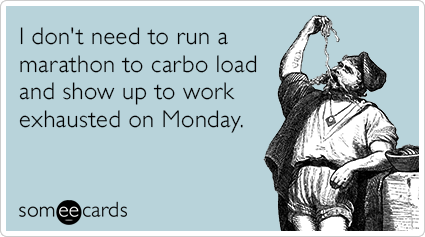I will normally be posting my weekly recaps on Monday mornings, so I thought I'd start out with an overview of what RLRF is.

After trying Hanson's Marathon Method this past summer and disliking it, I knew I wanted to try a more balanced plan. I missed swimming, and spending more than two hours running on weekdays didn't really work for me.
I did some searching and came across the RLRF plan, produced by the Furman Institute of Running and Scientific Training (FIRST). I had seen this book before at the library, but for some reason I didn't realize it was a training plan, so I had never thumbed through it.
After a little bit of Internet research, I ordered up my very own copy. It's about as different from Hanson's as is physically possible, so I found it very interesting that their training was conceived using the same fundamental ideas. Their five main principles are: progressive overload, specificity, individual differences, law of diminishing returns, and reversibility.
Progressive overload means that training stress will increase gradually, so that the body adapts, rather than breaks. Specificity dictates that runs on the plan will be fast, just like the goal race should be fast. The authors also emphasize acknowledging your individual differences from other runners and adapting the plan as necessary, as each person needs something slightly different to succeed. They also promote the law of diminishing returns - at some point, running more miles will not result in a proportional gain. Finally, reversibility, meaning that training progress can be lost, led them to make only three days a week rung days, making it more likely that runners will take fewer hiatuses.

Like I mentioned above, RLRF is set up to have three runs every week, and each one is a different kind of key workout: first comes a track workout, followed by a tempo run, and finished off with a long run. This is supplemented with three cross-training days, two mandatory and one optional. (The book provides sample workouts for each week for swimming, cycling, and rowing.)

They also encourage strength-training, which I will be doing twice a week. This wasn't discussed very well in the book, but I found a Powerpoint online FIRST had produced on what exercises to do and when. (I'm only modifying the routine to include exercises to hit my low back and hip abductors, since those are my problem spots.)
I tried to find some blog reviews of RLRF to get an idea of what I was in for. I didn't find very many, but what I did find was a lot of vitriol for this plan, mostly from runners who've never tried it. I know RLRF seems radical on the surface, but once I realized the cross-training workouts replace easy runs, it seemed perfectly sensible to me - no one would argue with a plan with five days of running a week. It's also clear that FIRST has spent a lot of time doing scientific research on this plan, so it's not like they're snake oil salesmen or anything. I'm hoping that over the next 16 weeks I can provide a more unbiased opinion on what the plan is really like.

The authors are big believers in setting a realistic goal, so training times are calculated using a recent 5K or 10K time. I used my 10K time from the Scrumpy Skedaddle (57:40), which gives me a projected marathon time of 4:27:36. (Side note - as long as your 5K time is between 16:00 and 40:00, you can use the tables!) I'm a little scared, since this is a marathon pace of 10:12 min/miles, but I'm going to give it my best shot.

Now that I'm working full-time, I like having my long runs on Saturdays best, so I'm starting each training week on Monday. Mondays and Wednesdays I will be swimming at lunch, Tuesdays and Thursdays I will be running before work and lifting at lunch, Saturdays I'll do my long run, and Sundays will be for a yoga class.

I think this program is totally going to kick my butt, but I'm super excited for it. I struggled with Hanson's because it was go go go all the time, with no step back weeks or real rest. I know the RLRF runs are going to put me through the ringer, but I think my mental game will be much stronger knowing I have one day (at least) off from running in between each workout. I'll be back in a week to let you know how I'm too sore to move.

What's your favorite training plan?
No comments:
Post a Comment